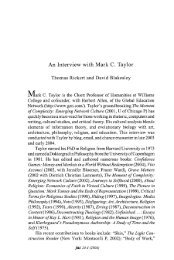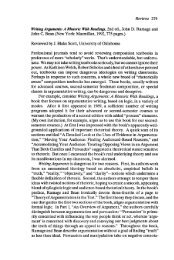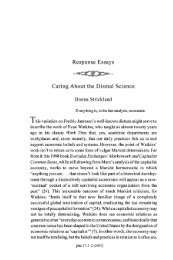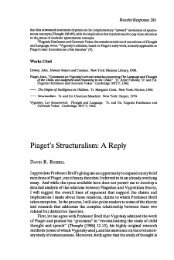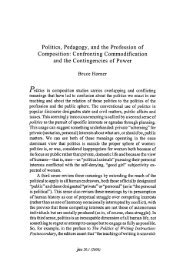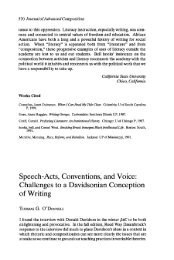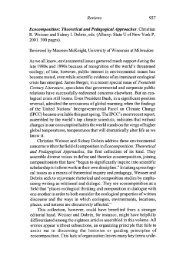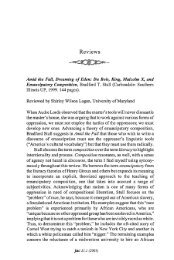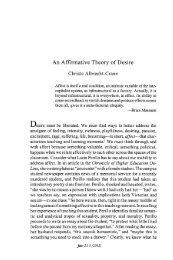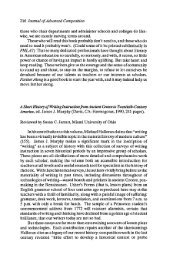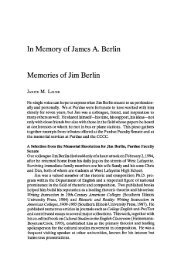Nance Van Winckel Pausing, or the act of reflection ... - JAC Online
Nance Van Winckel Pausing, or the act of reflection ... - JAC Online
Nance Van Winckel Pausing, or the act of reflection ... - JAC Online
Create successful ePaper yourself
Turn your PDF publications into a flip-book with our unique Google optimized e-Paper software.
<strong>Nance</strong> <strong>Van</strong> <strong>Winckel</strong> 107<br />
writer would ra<strong>the</strong>r not go back to a conscious focus on <strong>the</strong> writing<br />
task's subject. These two problems also indicate <strong>the</strong> need<br />
f<strong>or</strong> a better balance between relaxation and attention.<br />
AMBIGUITY<br />
Generating ideas <strong>or</strong> inf<strong>or</strong>mation f<strong>or</strong> <strong>the</strong> wrmng task depends,<br />
in part, on unfocusing <strong>or</strong> deliberately bringing about ambiguity.<br />
J. P. Guilf<strong>or</strong>d was among <strong>the</strong> first to stress <strong>the</strong> so-called<br />
"creative person's" higher tolerance f<strong>or</strong> ambiguity, a willingness<br />
to remain suspended in a chaos <strong>of</strong> w<strong>or</strong>dless thoughts and images.<br />
O<strong>the</strong>r studies in cognition have concluded that those less comf<strong>or</strong>table<br />
with mental chaos are apt to choose one image very<br />
quickly, perhaps too quickly, from <strong>the</strong> confusion <strong>of</strong> images and<br />
to begin at once to w<strong>or</strong>k consciously-moving back to <strong>the</strong> analytic<br />
left brain-to make that image w<strong>or</strong>k. This concept, part <strong>of</strong><br />
<strong>the</strong> larger <strong>the</strong><strong>or</strong>y <strong>of</strong> cognitive dissonance, holds that such people<br />
depend largely on processes <strong>of</strong> logic and reason to f<strong>or</strong>ce certain<br />
images and ideas into m<strong>or</strong>e effective verbal constructs. And,<br />
though <strong>the</strong>se constructs are <strong>of</strong>ten effective, researchers in creative<br />
thinking are quick to point out that <strong>the</strong> longer one is able<br />
to tolerate cognitive chaos, <strong>the</strong> better one's chances f<strong>or</strong> initially<br />
choosing a m<strong>or</strong>e easily w<strong>or</strong>kable and interesting image <strong>or</strong> idea to<br />
contribute to <strong>the</strong> task at hand. Or, as G<strong>or</strong>don succinctly puts<br />
it, "Ultimate solution to problems are rational; <strong>the</strong> process <strong>of</strong><br />
finding <strong>the</strong>m is not." 1 3<br />
Remaining in a state <strong>of</strong> ambiguity where indistinct images<br />
and w<strong>or</strong>dless thoughts proliferate may again be likened to remaining<br />
at that fulcrum between left and right brains, between<br />
consciousness and subconsciousness. Seeing this point <strong>of</strong> balance<br />
between left and right brains as a fulcrum helps us to understand<br />
what brain scientists think occurs in preconsciousness. Lawrence<br />
Kubie asserted <strong>the</strong> imp<strong>or</strong>tance <strong>of</strong> preconscious processes f<strong>or</strong> creative<br />
thought several years ago. He believed preconsciousness to<br />
be that place between logical and a-logical thinking where ideas<br />
were reshuffled, compared, and amalgamated in <strong>or</strong>iginal ways:<br />
In <strong>the</strong> preconscious use <strong>of</strong> imagery and alleg<strong>or</strong>y many experiences<br />
are condensed into a single hieroglyph, which<br />
expresses in one symbol far m<strong>or</strong>e than one can say slowly



